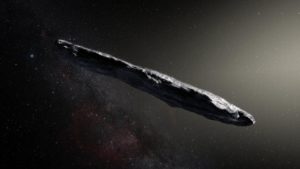‘It moves like a piece of driftwood on the tide,’ astronomer says

Shocked astronomers had never seen anything like it: a bizarrely shaped rock ejected from another stellar system, just passing through ours.
So strange was the discovery back in October, astronomers around the world turned their telescopes toward the cigar-shaped asteroid in the hope of uncovering its mysteries — including even listening for signs of alien life.
Breakthrough Listen, one arm of an international project dedicated to searching for signs of intelligent life in the universe, started eavesdropping earlier this month using a telescope in West Virginia. But the group says it has found no evidence of artificial signals coming from the rock known as 1I/2017 U1 ‘Oumuamua, which means “messenger from afar who arrived here first” in Hawaiian.
The organization says it continues to listen across other radio frequencies and analyze the collected data.
Other stars, other worlds
Michele Bannister of Queen’s University Belfast says the chance to study something that came from another solar system can provide scientists with crucial information to test their theory of planetary evolution.
“We can do stuff here that we simply can never do in detail for other systems. And then a piece of one comes visiting!” said Bannister, the lead author of a new study about ‘Oumuamua that was accepted for publication in the journal Earth and Planetary Astrophysics.
“We can actually connect the theory to the reality.”
‘Oumuamua, which is about 400 metres long and 40 metres wide, raises many questions Bannister would love to answer.
“I would like to know what its home star system looked like,” she said. “I want another one. I want to know this object isn’t unusual. Is it statistically a reasonable example of what we expect to see wandering the cosmos?”

She says with more and more telescopes dedicated to sky surveys, the chances of discovering more rocks drifting from other solar systems are increasing.
“That’s something that I’m really looking forward to: the launch of the new field of interstellar asteroid research,” she said. “[‘Oumuamua is] going to have friends.”
‘Weird’ rock
Astronomers have discovered ‘Oumuamua resembles worlds in our outer solar system, beyond the orbit of Neptune, which helps shed some light on planetary formation.
‘Oumuamua, for example, has a significant carbon content. Astronomers believe that carbon-rich material, together with cosmic ray bombardment, should colour an object like an asteroid bright red.
But this didn’t happen with ‘Oumuamua.
“This object has been travelling between stars for millions, perhaps billions of years, so it would have had a lot of cosmic bombardment,” Bannister said. “So [you’d expect] maybe it would be ultra-red. But it’s not.”
Instead, the colour is a more neutral red, similar to what you’d find on objects in the Kuiper Belt — the outer region of our solar system, home to icy worlds — such as Pluto and its largest moon Charon.

“This object is very much similar to 15 per cent of the outer solar system,” Bannister said. “It’s a little weird, but it’s familiar.”
Bannister, who worked as a post-doctoral researcher at the NRC’s Herzberg Centre in Victoria, said her study wouldn’t have been possible without the work of a Canadian-led study called Colours of OSSOS, which has been mapping the objects in the outer reaches of the solar system.
Another surprise
When ‘Oumuamua was first discovered, astronomers believed it was likely a comet. That’s because as stellar systems form, most of the objects thrown into space are comets, leftover bits made up of water and dust. Asteroids, on the other hand, are mostly rocky remnants and much less common.
But as ‘Oumuamua neared the sun, the familiar tail that comets produce didn’t appear, an indication that it’s mostly rock.
As ‘Oumuamua makes its way out of the solar system at roughly 38 kilometres a second, tumbling from end to end, researchers still aren’t sure exactly where it came from.
“It moves like a piece of driftwood on the tide,” Bannister said. “It’s really celestial driftwood.”


